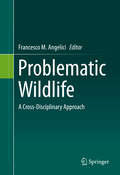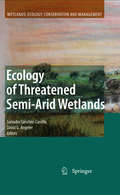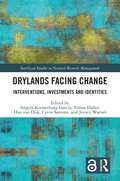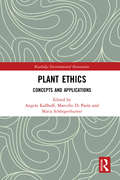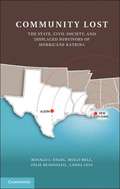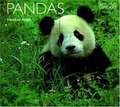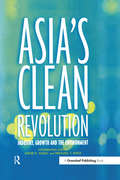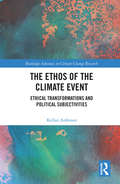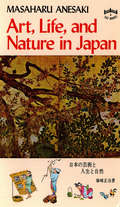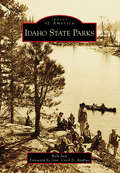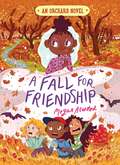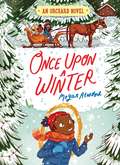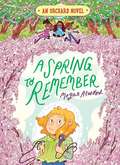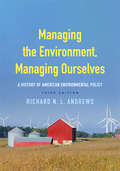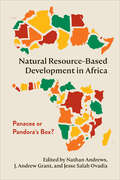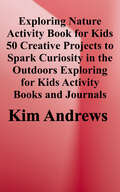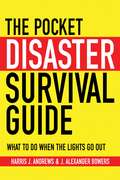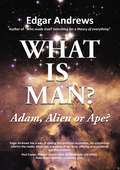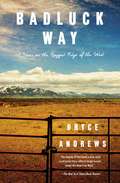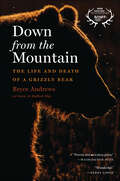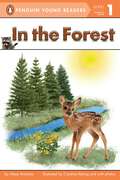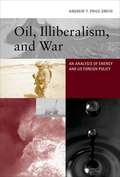- Table View
- List View
Problematic Wildlife
by Francesco M. AngeliciThis book provides insight into the instancesin which wildlife species can create problems. Some species trigger problemsfor human activities, but many others need humans to save them and to continueto exist. The text addresses issues faced by economists and politicians dealingwith laws involving actions undertaken to resolve the problems of theinteraction between humans and wildlife. Here, the words 'problematic species'are used in their broadest sense, as may be appreciated in the short introductionsto the various sections. At times, the authors discuss special cases whilealways extending the discussion into a more general and broad vision. At others,they present real cutting-edge analysis of ecological topics and issues. The book will be of interest to biologists,ecologists and wildlife managers involved in research on wildlife, parks, andenvironmental management, as well as to government departments and agencies,NGOs and conservation wildlife organizations. Even those in contact with nature,such as hunters, herders, and farmers, will be able to find a great deal ofimportant information. Specific case studies are selected from among the mostsignificant and prevalent cases throughout the world. A total of 26 papers have been selected forthis book, written by zoologists, biologists and ecologists. Many have aninterdisciplinary approach, with contributions by economists, criminologists, technicalspecialists, and engineers.
Ecology of Threatened Semi-Arid Wetlands
by David G. Angeler Salvador Sánchez-CarrilloPlaying a critical role in both influencing climate change and mitigating its impacts, the world's diverse wetlands have become one of the world's most threatened ecosystems as unsustainable land-use practices coupled with irrational use of water have already resulted in large-scale wetlands loss and degradation. To develop sound management and conservation schemes to assure wetlands sustainability in the long term requires long-term understanding of wetlands ecology. Yet until now, long-term interdisciplinary research into these systems has been limited to only a few systems from tropical or temperate climates (such as the Florida Everglades, and Czech biosphere reserve). This new book adds to the existing wetlands literature, providing a unique reference in basic and applied Mediterranean wetland ecology, based on results from long-term interdisciplinary research at the RAMSAR and UNESCO Biosphere site, of Las Tablas de Daimiel, Spain. Dating back to the early 1990s the research highlights changes in the biotic and abiotic environment in response to cumulative anthropogenic stressors, and provide guidance on applying this understand to sound management and conservation. With particular relevance to researchers dealing with semi-arid wetlands in the Mediterranean and elsewhere, as well as to resource managers, the book discusses the complexity of the interacting abiotic and biotic environment across different spatial and temporal scales and across various levels of biological hierarchy is highlighted, and reveals how management based on poor knowledge causes more damage than repair. The book will be of interest to researchers interested in freshwater ecology, hydrobotany, hydrology, geology, biogeochemistry, landscape ecology and environmental management.
Drylands Facing Change: Interventions, Investments and Identities (Earthscan Studies in Natural Resource Management)
by Angela Kronenburg García, Tobias Haller, Han van Dijk, Cyrus Samimi, Jeroen WarnerThis edited volume examines the changes that arise from the entanglement of global interests and narratives with the local struggles that have always existed in the drylands of Africa, the Middle East, and Central Asia and Inner Asia. Changes in drylands are happening in an overwhelming manner. Climate change, growing political instability, and increasing enclosures of large expanses of often common land are some of the changes with far-reaching consequences for those who make their living in the drylands. At the same time, powerful narratives about the drylands as ‘wastelands’ and their ‘backward’ inhabitants continue to hold sway, legitimizing interventions for development, security and conservation, informing re-emerging frontiers of investment (for agriculture, extraction, infrastructure), and shaping new dryland identities. The chapters in this volume discuss the politics of change triggered by forces as diverse as the global land and resource rush, the expansion of new Information and Communication Technologies, urbanization, the COVID-19 pandemic, and the spread of violent extremism. While recognizing that changes are co-produced by differently positioned actors from within and outside the drylands, this volume presents the dryland’s point of view. It therefore takes the views, experiences, and agencies of dryland dwellers as the point of departure to not only understand the changes that are transforming their lives, livelihoods, and future aspirations, but also to highlight the unexpected spaces of contestation and innovation that have hitherto remained understudied. This edited volume will be of much interest to students, researchers and scholars of natural resource management, land and resource grabbing, political ecology, sustainable development and drylands in general.
Plant Ethics: Concepts and Applications (Routledge Environmental Humanities)
by Angela Kallhoff, Marcello Di Paola and Maria SchörgenhumerLarge parts of our world are filled with plants, and human life depends on, interacts with, affects and is affected by plant life in various ways. Yet plants have not received nearly as much attention from philosophers and ethicists as they deserve. In environmental philosophy, plants are often swiftly subsumed under the categories of "all living things" and rarely considered thematically. There is a need for developing a more sophisticated theoretical understanding of plants and their practical role in human experience. Plant Ethics: Concepts and Applications aims at opening a philosophical discussion that may begin to fill that gap. The book investigates issues in plants ontology, ethics and the role of plants and their cultivation in various fields of application. It explores and develops important concepts to shape and frame plants-related philosophical questions accurately, including new ideas of how to address moral questions when confronted with plants in concrete scenarios. This edited volume brings together for the first time, and in an interdisciplinary spirit, contemporary approaches to plant ethics by international scholars of established reputation. It will be of great interest to students and scholars of Philosophy and Ethics.
Community Lost: The State, Civil Society, and Displaced Survivors of Hurricane Katrina
by Ronald J. Angel Holly Bell Julie Beausoleil Laura LeinNeither government programs nor massive charitable efforts responded adequately to the human crisis that was Hurricane Katrina. In this study, the authors use extensive interviews with Katrina evacuees and reports from service providers to identify what helped or hindered the reestablishment of the lives of hurricane survivors who relocated to Austin, Texas. Drawing on social capital and social network theory, the authors assess the complementary, and often conflicting, roles of FEMA, other governmental agencies, and a range of non-governmental organizations in addressing survivors' short- and longer-term needs. While these organizations came together to assist with immediate emergency needs, even collectively they could not deal with survivors' long-term needs for employment, affordable housing, and personal records necessary to rebuild lives. Community Lost provides empirical evidence that civil society organizations cannot substitute for an efficient and benevolent state, which is necessary for society to function.
Panda
by Heather AngelWith its large, friendly face and eyes exaggerated by black eye patches, China's national treasure, the giant panda, is instantly recognizable.Giant pandas spend most f their time trying to eat enough bamboo to survive. The rest is spent conserving energy, and solitary pandas can be seen strolling along, stopping to recline on riverside rocks or amongst ferns. The lower body-weight and physical size of panda cubs mean that they have more energy to spend, and are seen climbing trees, play-fighting, doing somersaults and playing with bamboo.Panda is a unique and intimate portrait of one of the world's best-loved animals. The extraordinary lives of the giant panda and the enchanting red panda are captured throughout the seasons in their remote mountain habitat. This selection of over 200 remarkable pictures shows pandas feeding, resting, playing, climbing trees and even sliding down snowy slopes, as well as showcasing the misty peaks and snow-clad forests of the beautiful Sichuan Province of China. Panda is a heart-warming and illuminating tribute to an endangered species that is loved the world over.
Panda
by Heather AngelGiant Pandas inspire affection and instant recognition with their distinctive white faces and black ears and eye patches. Meet China's national treasure, pictured in a natural, protected mountain habitat where we have the chance to follow on photographer Heather Angel's shoulder as she reveals pandas as we have never seen them: playing in the snow, a mother with baby, leading their lives, apparently oblivious of one another.
Pandas (WorldLife Library)
by Heather Angel"Pandas" is a fascinating introduction to these popular yet seldom-seen animals. Join wildlife photographer and zoologist Heather Angel on her personal adventure as she journeys into the depths of China to catch a glimpse of the endangered giant panda and the red panda. From this collection of glorious photographs and descriptive text, you'll learn details about the panda's eating habits, habitat, and behavior, as well as conservation issues relating to its survival and endangered species status. Heather Angel trained as a zoologist and worked as a marine biologist before becoming a professional wildlife photographer. She has visited China twelve times, including four visits specifically to photograph pandas. While she was president of the Royal Photographic Society, she led a small British photographic delegation to China in 1985, when an exhibition of her wildlife photographs was staged in Beijing. In 1994, she was appointed a special professor at Nottingham University, where she teaches part of the photography module. In 1998, she was elected as the Louis Schmidt Laureate by the Biological Photographic Association. Professor Angel lives in England.
Asia's Clean Revolution: Industry, Growth and the Environment
by David Angel Michal RockThe world's environmental future will be determined in significant part by what happens in the rapidly industrialising and urban economies of Asia. The sheer scale of urban population and industrial growth in Asia - from Indonesia to China - and the energy and materials intensive character of the development process constitutes a dark shadow over the region's, and indeed the world's, environment. And yet this challenge is also an opportunity. Precisely because so much of the urban-industrial investment within developing Asia has yet to take place, the opportunity exists to shape a different development future - one that is far less energy, materials and waste intensive.Asia's Clean Revolution examines the prospects for and pathways to such a new trajectory. The book lays out a path-breaking vision of how developing economies might go beyond environmental regulation and put in place an array of policies and institutions that could integrate environmental, industrial and technological goals. These findings provide important input for negotiators considering climate change on a global scale.The book approaches the challenge of growth and environment in Asia in a novel way, by identifying six major transformational dynamics under way in the world today, and assessing whether these can be harnessed to the goal of improved environmental performance of industry.With a set of specially commissioned chapters from the leading authorities in North America and Asia, this ground-breaking book is the first to present concrete policy solutions to the looming crisis driven by large-scale urban-industrial growth in developing Asia.
The Ethos of the Climate Event: Ethical Transformations and Political Subjectivities (Routledge Advances in Climate Change Research)
by Kellan AnfinsonThis book develops a politico-ethical response to climate change that accounts for the novelty and uncertainty that it entails. This volume explores the ethical dimensions of climate change and posits that one must view it as a social construction intimately tied to political issues in order to understand and overcome this environmental challenge. To show how this ethos builds upon the need for new forms of responsiveness, Anfinson analyzes it in terms of four features: commitment, worldly sensitivity, political disposition, and practice. Each of these features is developed by putting four thinkers – Kierkegaard, Nietzsche, Schmitt, and Foucault respectively – in conversation with the literature on climate change. In doing so, this book shows how social habits and norms can be transformed through subjective thought and behavior in the context of a global environmental crisis. Presenting a multidisciplinary engagement with the politics, philosophy, and science of climate change, this book will be of great interest to students and scholars of climate change, environmental politics, environmental philosophy and environmental humanities.
Art, Life, and Nature in Japan
by Masaharu Anesaki Terence BarrowThe artistic and philosophical heritage of Japan has a special meaning for the modern world. During the present century, Japanese thought and Japanese art have exerted a strong influence on the western mind. Art, Life, and Nature in Japan takes us to the roots of Japanese culture and the origins of this influence.In this brief but deeply meaningful book Masaharu Anesaki provides a panoramic view of Japanese culture, with particular emphasis on the spirit of Japanese art. The book has, in fact, established itself as a classic, and it ranks with such other valuable works of its time as The Book of Tea, in which Kakuzo Okakura deals with a similar theme.Anesaki expresses himself in crystal-clear English to convey a message that is significant today as it was before World War II, when his book first appeared. He advocates peace and a turning inward to the beauty of art and nature. He is as familiar with the Zen philosophy of the samurai and the tea master as with sentiments of ancient court noblemen and the quiet thought of a humble peasant.
Idaho State Parks (Images of America)
by Foreword By Andrus Rick JustIdaho’s state parks have been called the “jewels” of the Gem State. The story of how those jewels came to be involves political intrigue, much resistance, some philanthropy, and a touch of irony. Sen. Weldon B. Heyburn famously said that state parks were “always a political embarrassment.” Idaho’s first state park was named after him. Today, Idaho’s 30 state parks host five million people a year. Visitors come to boat, camp, bike, climb, hike, fish, and make memories in the great outdoors. This book tells the story of Idaho’s diverse state parks—from Priest Lake in Idaho’s panhandle to Bear Lake in the southeast corner of the state—through a wealth of historical photographs. A variety of parks are featured, including ones that were lost, found, or never came to fruition.
A Fall for Friendship (An Orchard Novel #3)
by Natalie Andrewson Megan AtwoodOlive doesn’t believe in ghosts, but something weird is definitely going on at the orchard and she wants to get to the bottom of it in this third novel of a sweet series about the bonds of friendship.Olive, Peter, Sarah, and Lizzie are getting ready for Halloween. This year, they’re planning a zombie hayride and a haunted barn party. As they set up, Lizzie’s older sister, Gloria tells them that a ghost haunts the very barn they’re decorating. According to Gloria, the ghost is angry and desperate for revenge. Lizzie, Sarah, and Peter are fascinated, but Olive doesn’t believe any of it. Not even when strange, ghostly things keep happening all around them. Olive sets out to prove that ghosts don’t exist and that Gloria and her friends are behind it all. But the more Olive investigates, the scarier things become. Could Gloria be telling the truth? Is the orchard really haunted?
Once Upon a Winter (An Orchard Novel #2)
by Natalie Andrewson Megan AtwoodWintertime at the orchard has Peter learning some important lessons about speaking up in this second novel of a sweet series about the bonds of friendship.Blanketed in snow, the orchard looks like a magical wonderland. But Peter is not so charmed by his new life. He just can’t ignore how he’s always ignored any longer. Sarah, Lizzie, and Olive are always talking over him and bossing him around. And on top of that, it’s really cold outside. One January day, Peter reluctantly agrees to join the girls on a carriage ride through the freshly fallen snow. But things go terribly wrong when a dog incident has the horses running away in fear, with Peter and the carriage trailing dangerously behind them. Then, Peter hits his head on a passing branch and is thrown to the ground. Woozy, Peter wakes up alone in the snow but he makes his way to a cozy cottage. Kai, the cool new kid, opens the door and welcomes Peter inside. Kai shows him a magical mirror that brings the two new friends to another world. A world where people listen to Peter and need his help to defeat dragons, warlocks, and other scary things. Then Peter wakes up in the hospital with a bandage around his head. Everyone is so happy to see him awake. Peter tries to tell them all about the mirror but they dismiss his experience as a wild dream. When Peter goes back to school, it seems like Kai knows what Peter’s talking about. Could the dream have been real? Is there really a magic portal deep in the woods behind the orchard? Even if everyone thinks he’s crazy, Peter is determined to find out.
A Spring to Remember (An Orchard Novel #4)
by Natalie Andrewson Megan AtwoodSpring has sprung and the orchard crew tries their hand at matchmaking in this final novel of a sweet series about the bonds of friendship.The orchard is putting on a Valentine’s Day dance! And the town is once again totally involved. Lizzie and her friends have been tasked with decorations. When all four of them go into town to buy them, they see Sheriff Hadley and Sarah’s mom kissing beside a building! Sarah is shocked. But she’s the only one. Lizzie tries to comfort her but then to her surprise, Sarah is thrilled! She’s so thrilled in fact, she wants to hurry them along. She wants a proposal. And she wants the gang’s help to get it. Lizzie is unsure—she thinks people should be able to do what they want. But Sarah is her best friend, so… Meanwhile, Lizzie has been taking singing lessons. She hates them—she’s really not that good. But her parents decided she needed to “find her voice” and thought this was a great way to do it. Lizzie doesn’t want to hurt their feelings so she doesn’t say anything. Sarah gets the gang to scheme ways to hint to Sheriff Hadley and her mom that they all know they’re together and they want them to get married. Now Lizzie’s really uncomfortable. Why doesn’t Sarah just talk to her mom? To make matters worse, her friends come up with an idea of a romantic moment at the Valentine’s Day Dance that involves a proposal and…a singing Lizzie. Can Lizzie find the courage to put a stop to all this? Or is she going to face her worst nightmare?
Coyote Valley: Deep History in the High Rockies
by Thomas G. AndrewsThomas Andrews drills deep into the many pressures that have reshaped a small stretch of North America, from the ice age to the advent of the Anthropocene and controversies over climate change. He brings to the surface lessons about the critical relationships to land, climate, and species that only seemingly unimportant places on Earth can teach.
Managing the Environment, Managing Ourselves: A History of American Environmental Policy
by Richard N. AndrewsIn the third edition of this definitive book, Richard N. L. Andrews looks back at four centuries of American environmental policy, showing how these policies affect contemporary environmental issues and public policy decisions, and identifying key policy challenges for the future. Andrews crafts a detailed and contextualized narrative of the historical development of American environmental policies and institutions. This volume presents an extensively revised text, with increased detail on the 50-year history of the modern environmental policy era and updated through the Obama and Trump administrations.
Natural Resource-Based Development in Africa: Panacea or Pandora’s Box?
by Nathan Andrews J. Andrew Grant Jesse Salah OvadiaThere is no question that Africa is endowed with abundant natural resources of different magnitudes. However, more than a decade of high commodity prices and new hydrocarbon discoveries across the continent has led countless international organizations, donor agencies, and non-governmental organizations to devote considerable attention to the potential of natural resource–based development. Natural Resource–Based Development in Africa places a particular emphasis on the actors that help us understand the extent to which resources could be transformed into broader developmental outcomes. Based on a wide variety of primary sources and fieldwork, including in-person interviews and participant observations, this collection contributes to both scholarly and policy discussions around the governance and economic development roles of local entrepreneurs, transnational firms, civil society groups, local communities, and government agencies in Africa’s natural resource sectors. Natural Resource–Based Development in Africa explores the impact that these actors have on regional trends such as resource nationalism and local procurement policies as well as grassroots-related issues such as poverty, livelihoods, gender equity, development, and human security.
Exploring Nature Activity Book for Kids: 50 Creative Projects to Spark Curiosity in the Outdoors
by Kim AndrewsA guide to exploring the great outdoors for kids ages 6 to 12. Encourage young nature lovers to get outside and track, explore, discover, and create. This book is filled with hands-on, educational outdoor activities that kids will love to learn from, like crafting bird feeders out of fruit, pressing flowers, or creating sundials. They'll get their hands dirty and their imaginations revving while staying active outside. <p><p>This standout among nature books for kids includes: 50 Fun outdoor projects―Inspire a lifetime of curiosity with tons of guided, interactive ideas that let kids observe animals, plants, and even outer space in action. <p>Activities for everyone, everywhere―the fun and games inside cover a range of seasons and regions so all kids can start exploring, no matter where they are. <p>Important skill-building--By stopping to notice and record what's going on around them, kids will practice important skills like observation, memory, writing, drawing, wildlife safety, and more. <p><p>This hands-on approach to nature books for kids will show kids what makes the great outdoors great.
The Pocket Disaster Survival Guide: What to Do When the Lights Go Out
by Harris J. Andrews J. Alexander BowersWhether it’s a hurricane bearing down on a home near the coast or a power line downed in a snowstorm near a car, are you prepared for these situations? This slim handbook will provide you with all the information you need to ensure that you, your family, and your pets can weather any emergency crisis. Learn the necessity of backing up important documents, how to safely store food and water for more than a day, and how to communicate with your family and emergency personnel should a disaster strike.
WHAT IS MAN?: Adam, Alien or Ape?
by Edgar AndrewsIn 1906, American humorist Mark Twain published a sixty-page essay entitled “What is man?” Consisting of an interminable dialogue between a senior citizen (who believes that man is just a machine) and a young man (who believes nothing in particular but is open to persuasion), it wasn’t one of his finest books. But at least he tried. Authors since then seem to have avoided the subject like the plague, often tackling the respective roles of men and women in society but seldom asking deeper questions about what it means to be human. When the psalmist asked, “What is man?” (Psalm 8 v.4) he was, I think, seeking an altogether more profound answer.Avoidance of the subject is all the more strange because there has never been a time like our own when curiosity about human origins and destiny has been greater, or the answers on offer more hotly disputed. It’s a safe bet that any attempt to give the “big picture” on the origin, nature and specialness of mankind will be contentious —which might explain why writers have generally fought shy of it. Yet at heart it is the question most of us really do want answered, because the answer defines that precious thing we call our identity, both personally and as a race.The Psalmist did, of course, offer his own answer three millennia ago. Man, he claimed, was created by God for a clearly defined purpose — to exercise dominion over planet earth and (by implication) to ultimately share something of the glory of the divine nature. The rest, as they say, is history, but it’s not a happy tale. As Mark Twain says in another essay; “I can’t help being disappointed with Adam and Eve”. Not surprisingly, then, a large proportion of humanity today are looking for alternative solutions, accepting the challenge of the Psalmist’s question without embracing the optimism of his answer.In this book we are going to consider the alternative solutions on offer by considering what it means to be human against the backgrounds of cosmology (man’s place in the universe), biology (man’s place in the animal kingdom), and psychology (man’s consciousness and mind). Finally, we return to the biblical context, arguing that the Psalmist got it right after all.Don’t let the science-sounding stuff put you off. Like its popular prequel, “Who made God? Searching for a theory of everything”, this book is written with a light touch in a reader-friendly and often humorous style. It is intended specifically for the non-expert, with homely verbal illustrations designed to explain and unpack the technicalities for the lay-person. As Dr. Paul Copan (Pledger Family Chair of Philosophy and Ethics, Palm Beach Atlantic University) says, "Edgar Andrews has a way of making the profound accessible. His scholarship informs the reader about key questions of our time, offering wise guidance and illumination."
Badluck Way: A Year on the Ragged Edge of the West
by Bryce Andrews"Mine might have been a simple, pretty story, if not for the wolves. In late July, they emerged from the foothills . . ." In this gripping memoir of a young man, a wolf, their parallel lives and ultimate collision, Bryce Andrews describes life on the remote, windswept Sun Ranch in southwest Montana. The Sun's twenty thousand acres of rangeland occupy a still-wild corner of southwest Montana--a high valley surrounded by mountain ranges and steep creeks with portentous names like Grizzly, Dead Man, and Bad Luck. Just over the border from Yellowstone National Park, the Sun holds giant herds of cattle and elk amid many predators--bears, mountain lions, and wolves. In lyrical, haunting language, Andrews recounts marathon days and nights of building fences, riding, roping, and otherwise learning the hard business of caring for cattle, an initiation that changes him from an idealistic city kid into a skilled ranch hand. But when wolves suddenly begin killing the ranch's cattle, Andrews has to shoulder a rifle, chase the pack, and do what he'd hoped he would never have to do. Badluck Way is about transformation and complications, about living with dirty hands every day. It is about the hard choices that wake us at night and take a lifetime to reconcile. Above all, Badluck Way celebrates the breathtaking beauty of wilderness and the satisfaction of hard work on some of the harshest, most beautiful land in the world. Called "an important meditation on what it means to share space and breathe the same air as truly wild animals" (Tom Groneberg, author of The Secret Life of Cowboys), Badluck Way is the memorable story of one young man's rebirth in the crucible of the West's timeless landscape, a place at the center of the heart's geography, savage and gorgeous in equal measure.
Down from the Mountain: The Life and Death of a Grizzly Bear
by Bryce AndrewsThe story of a grizzly bear named Millie: her life, death, and cubs, and what they reveal about the changing character of the American West. An "ode to wildness and wilderness" (Outside Magazine), Down from the Mountain tells the story of one grizzly in the changing Montana landscape. Millie was cunning, a fiercely protective mother to her cubs. But raising those cubs in the mountains was hard, as the climate warmed and people crowded the valleys. There were obvious dangers, like poachers, and subtle ones, like the corn field that drew her into sure trouble. That trouble is where award-winning writer, farmer, and conservationist Bryce Andrews's story intersects with Millie’s. In this "welcome and impressive work" he shows how this drama is "the core of a major problem in the rural American West—the disagreement between large predatory animals and invasive modern settlers”—an entangled collision where the shrinking wilds force human and bear into ever closer proximity (Barry Lopez).“Andrews’s wonderful Down from the Mountain is deeply informed by personal experience and made all the stronger by his compassion and measured thoughts . . . Welcome and impressive work.”—Barry Lopez
In the Forest (Penguin Young Readers, Level 1)
by Alexa AndrewsLearn all about what lives and grows in the forest in the three stories of this Level 1 nonfiction reader. Deer and other wildlife, trees and other plant life, and much more are found In the Forest!
Oil, Illiberalism, and War
by Andrew T. Price-SmithThe United States is addicted to crude oil. In this book, Andrew Price-Smith argues that this addiction has distorted the conduct of American foreign policy in profound and malign ways, resulting in interventionism, exploitation, and other illiberal behaviors that hide behind a facade of liberal internationalism. The symbiotic relationship between the state and the oil industry has produced deviations from rational foreign energy policy, including interventions in Iraq and elsewhere that have been (at the very least) counterproductive or (at worst) completely antithetical to national interests.Liberal internationalism casts the United States as a benign hegemon, guaranteeing security to its allies during the Cold War and helping to establish collaborative international institutions. Price-Smith argues for a reformulation of liberal internationalism (which he terms shadow liberalism) that takes into account the dark side of American foreign policy. Price-Smith contends that the "free market" in international oil is largely a myth, rendered problematic by energy statism and the rise of national oil companies. He illustrates the destabilizing effect of oil in the Persian Gulf, and describes the United States' grand energy strategy, particularly in the Persian Gulf, as illiberal at its core, focused on the projection of power and on periodic bouts of violence. Washington's perennial oscillation between liberal phases of institution building and provision of public goods and illiberal bellicosity, Price-Smith argues, represents the shadow liberalism that is at the core of US foreign policy.
